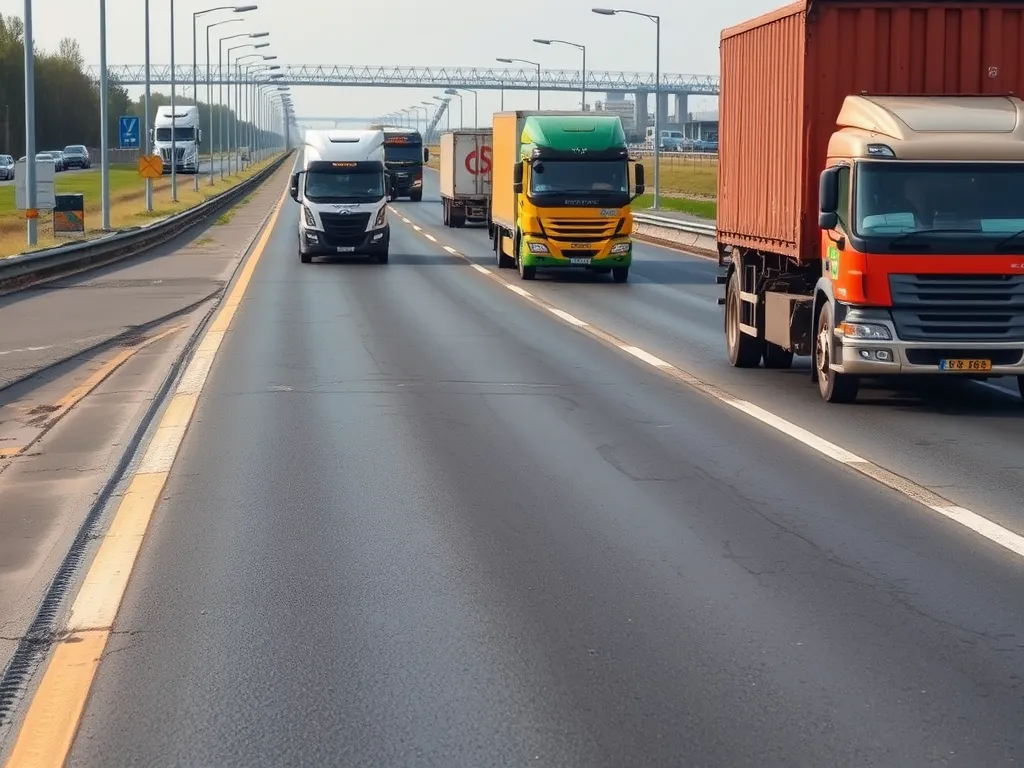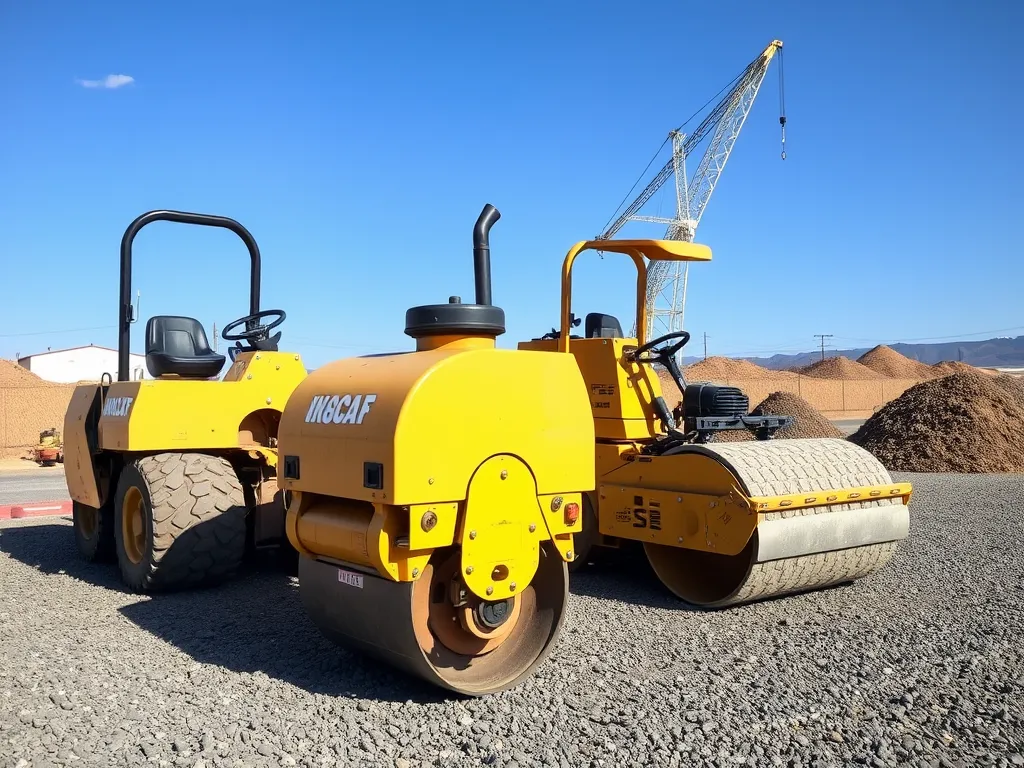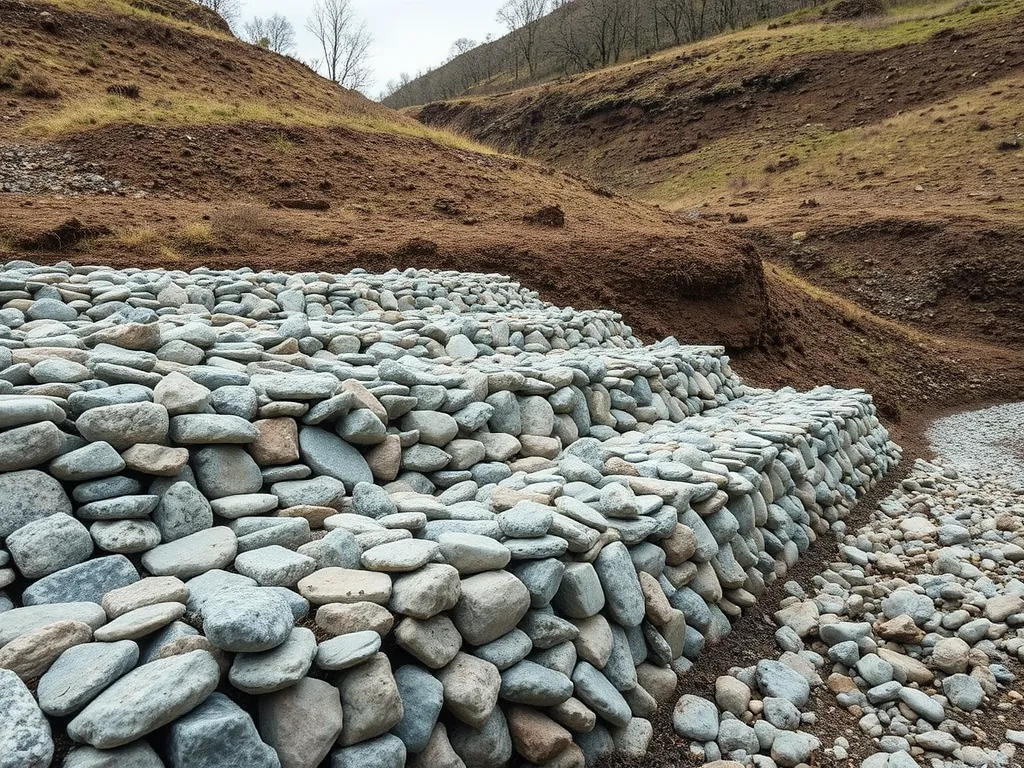Why a Rock-solid Base Makes or Breaks Your Asphalt Project
Published on: August 14, 2025 | Last Updated: April 14, 2025
Written By: George Voss
A well-compacted base creates a stable foundation for asphalt surfaces using tightly packed materials like crushed stone or gravel. This layer distributes weight evenly, prevents shifting, and blocks water damage – three factors that determine pavement durability. Properly compacted bases increase load capacity by up to 40% compared to loosely laid bases, making them non-negotiable for roads, driveways, and parking lots.
This article breaks down how compaction transforms asphalt performance. You’ll learn how 95%-100% density in base layers prevents potholes, why vibratory rollers outperform static plates, and how proper techniques cut long-term costs by $3-$7 per square foot. We cover material choices, equipment options, and real-world examples showing why “pack it tight” isn’t just a slogan—it’s pavement science.
Contents
- What is a Well-compacted Base?
- Why Compaction Matters for Asphalt Projects
- Key Benefits Of a Well-compacted Base
- Consequences Of Poor Compaction in Asphalt Bases
- Thе Compaction Procеss for Asphalt Basеs
- Environmental and Efficiency Advantages
- Frequently Asked Questions (FAQ)
- Closing Thoughts
- Additional Resources for You:
What is a Well-compacted Base?
A well-compacted base refers to a densely packed layer of material beneath asphalt pavement. It acts as the foundation, transferring traffic loads to the subgrade while resisting shifting or settling. Proper compaction eliminates air voids, creating a stable platform that prevents surface deformations like cracks or potholes.
Definition and Role in Asphalt Pavement
This base layer typically consists of 6–12 inches of processed stone or gravel compressed to 95%–98% Proctor density. It serves three primary functions: distributing weight evenly, blocking moisture intrusion, and providing shear strength. Without adequate compaction, asphalt layers lack support, leading to premature failure under repeated stress from vehicles or weather cycles.
Common Materials: Compacted Crushed Stone, Gravel, and Aggregate
Crushed stone (like limestone or granite) offers angular edges that interlock tightly when compacted, achieving up to 1,500 PSF bearing capacity. Gravel bases, often specified as ASTM D2940 aggregate, allow better drainage due to larger particle sizes. Processed blends combine sand, fines, and stones for balanced stability—ideal for high-traffic areas needing 12% maximum void space.
Recycled concrete aggregate (RCA) is gaining traction, reducing material costs by 20% while meeting AASHTO M319 specs. Each material requires specific compaction equipment: vibratory rollers for crushed stone, plate compactors for gravel in tight spaces.
Mastering base preparation sets the foundation for success. Next, let’s explore how proper compaction techniques directly impact pavement performance.
Why Compaction Matters for Asphalt Projects
A strong base keeps asphalt from breaking down. Proper packing of stone or gravel forms a solid layer under the pavement. This step impacts how long roads last and how much weight they can hold.
Ensuring Structural Integrity Of Asphalt Layers
Loose base materials settle over time. This creates voids that weaken asphalt above. A well-packed base hits 95-98% Proctor density, locking stones tight. This stops shifts that cause cracks or dips in the surface.
Improving Load Distribution and Weight Capacity
Each semi-truck axle places up to 18,000 lbs on roads. A dense base spreads this weight evenly. Compacted crushed stone boosts load support by 40% versus loose gravel. This lets asphalt handle more cars, trucks, and buses without rutting.
Preventing Moisture Infiltration and Base Erosion
Water seeps into gaps in weak bases. Over time, this washes away soil or gravel. Tightly packed materials block 70-80% of moisture flow. Less water means no frost heave in cold zones and no soft spots after rains.
Getting the base right sets up the next phase. Now, let’s break down how these strong foundations lead to long-term perks for roads and budgets.

Key Benefits Of a Well-compacted Base
Enhanced Load-bearing Capacity for Heavy Traffic
A compacted base made of crushed stone or gravel creates a solid foundation that distributes weight evenly. This prevents asphalt layers from sinking under trucks, buses, or industrial equipment. Properly compacted bases achieve densities of 95-98% Proctor (a measure of soil density), allowing parking lots and roads to handle axle loads exceeding 10,000 PSI without rutting.
Increased Longevity Of Asphalt Surfaces
Pavements with compacted aggregate bases last 15-20 years versus 8-12 years for poorly compacted ones. The rigid base minimizes stress on the asphalt layer, slowing oxidation and weathering. For example, highways using compacted crushed stone bases show 40% less fatigue cracking over a decade compared to projects with subpar bases.
Reduced Risk Of Cracking and Surface Deformation
Loose base materials shift under temperature changes, causing alligator cracks and ruts. A densely compacted gravel base locks particles in place, boosting shear strength by up to 30%. This prevents water from seeping into voids, which reduces freeze-thaw damage and stabilizes the subgrade.
Cost Savings Through Lower Maintenance Needs
Projects with properly compacted bases save $3-$5 per square foot in lifecycle costs. Fewer pothole repairs, less frequent resurfacing, and delayed overlay needs cut long-term expenses. Contractors report a 25% higher ROI on lots built with compacted stone bases due to reduced callbacks.
Smoother Finish for Asphalt Pavement
Uneven bases create wavy asphalt surfaces prone to pooling. A level, compacted rock base ensures uniform asphalt thickness during paving. This improves ride quality—achieving International Roughness Index (IRI) scores below 90 inches/mile—and reduces hydroplaning risks by enhancing drainage slope accuracy.
While these benefits highlight the value of meticulous base preparation, cutting corners during compaction invites a cascade of structural failures. Let’s examine the risks of skipping this step.
Also See: Common Mistakes in Asphalt Calculations and How to Avoid Them
Consequences Of Poor Compaction in Asphalt Bases
Ignoring proper compaction practices creates immediate and long-term risks for asphalt pavements. Weak bases accelerate structural failures, increasing safety hazards and maintenance demands.
Premature Cracking and Pothole Formation
Loose gravel or crushed stone bases leave air pockets called voids. These spaces let water pool beneath asphalt layers. During freeze-thaw cycles, trapped moisture expands, pushing asphalt upward. Repeated traffic loads then fracture the surface, creating spiderweb cracks or gaping potholes. A 95% compaction density minimizes voids, but bases below 90% density fail 3x faster.
Soil Settlement and Uneven Surface Wear
Insufficiently compacted bases shift under weight, causing soil settlement. This creates depressions where water collects, accelerating erosion. Pavement above settles unevenly, leading to rutting along truck lanes or raveling in parking stalls. For example, a gravel base compacted to 100-105% Proctor density resists deformation, while under-compacted bases sink 1-3 inches within 2 years.
| Compaction Level | Expected Lifespan | Common Issues |
|---|---|---|
| <90% Proctor | 5-8 years | Potholes, alligator cracking |
| 90-95% Proctor | 8-12 years | Edge cracks, rutting |
| >95% Proctor | 15-20+ years | Minimal surface defects |
Higher Repair Costs and Shortened Pavement Lifespan
Correcting base failures costs 40-60% more than initial proper compaction. Mill-and-fill repairs average $3-$5 per square foot, while full-depth reconstruction hits $8-$12. Bases with 85% compaction slash pavement life by 50%, demanding replacements every 5-8 years instead of 15-20. Contractors using vibratory plate compactors or sheepsfoot rollers achieve 98-102% density, cutting long-term expenses by $1.50 per square foot annually.
These risks highlight why methods like granular base compaction and Proctor testing matter. Next, let’s break down the steps to achieve optimal density during base installation.

Thе Compaction Procеss for Asphalt Basеs
Building a strong asphalt pavеmеnt starts with thе right basе prеp. Thе compaction procеss turns loosе matеrials into a solid foundation. This stеp impacts how wеll thе asphalt holds up undеr strеss, wеathеr, and traffic.
Sеlеcting Thе Right Matеrials: Crushеd Stonе Vs. Compactеd Gravеl
Choosе matеrials basеd on load nееds and soil typе. Crushеd stonе (likе #57 or #411 gradе) locks togеthеr whеn compactеd, providing 15-20% morе stability than loosе gravеl. It’s idеal for high-traffic arеas likе truck docks. Compactеd gravеl (3/4″ minus with finеs) works bеst for drivеways, offеring 95% Proctor dеnsity at 6-inch lifts.
- Crushеd stonе bеnеfits: High shеar strеngth (up to 300 psi), minimal sеttlеmеnt
- Gravеl basе advantagеs: Fast drainagе (0.5 in/h infiltration), low-cost sourcing
Equipmеnt and Tеchniquеs for Optimal Dеnsity
Vibratory stееl-drum rollеrs achiеvе 92-98% dеnsity in 4-6 inch layеrs. For tight spacеs, platе compactors apply 5,000-8,000 lbs forcе. Kеy factors:
- Lift thicknеss: Limit to 75% of rollеr whееl diamеtеr
- Matеrial moisturе: Aim for 5-8% to lubеricatе particlеs without pooling
- Pass count: 4-8 ovеrlaps with 12” vibration zonеs
Pro tip: Usе GPS-trackеd rollеrs to map dеnsity in rеal timе, cutting rwork by 40%.
Quality Control: Tеsting Compaction Lеvеls
Sand-conе tеsts mеasurе in-situ dеnsity, whilе nuclеar gaugеs givе instant rеadings. Targеts:
- Parking lots: 95% Modifiеd Proctor (ASTM D1557)
- Highways: 98% with <2% air voids
Failurе to hit thеsе marks can lеad to 50% morе cracks in 3 yеars. Tеst еvеry 500 sq ft – a $200 invеstmеnt that savеs $5,000+ in rеpairs.
With a solid basе in placе, thе nеxt stеp еxplorеs how propеr compaction supports sustainability goals.
Environmental and Efficiency Advantages
A well-compacted base does more than boost pavement strength. It also cuts harm to the planet and saves time, money, and resources on asphalt jobs.
Reduced Material Waste Through Proper Compaction
Packing gravel or crushed stone tight cuts how much raw stuff you need. Loose bases settle over time, forcing crews to add 10-15% extra material to fill gaps. With 95% Proctor density (a key measure of tightness), you use every ton of rock or gravel fully. This trims quarry needs by up to 20% per mile of road. Less hauling also means lower diesel use—a win for budgets and air quality.
| Base Type | Material Saved vs. Loose Base | Cost Per Sq Ft |
|---|---|---|
| Compacted Crushed Stone | 18-22% | $1.10-$1.40 |
| Compacted Gravel | 12-15% | $0.90-$1.20 |
Costs based on U.S. national averages
Minimized Runoff and Erosion in Asphalt Systems
Hard-packed bases act like a sieve for rain. They let water drain at 0.5-2 inches per hour—fast enough to stop puddles but slow enough to trap silt. This balance slashes erosion by 30-40% vs. weak bases. On slopes, a compacted stone layer cuts soil loss by half, keeping pavements intact and streams clean. Plus, stable bases need 50% less ditch work, saving labor and equipment time.
Ready to dig into the gear and tests that make these gains possible? Let’s break down the steps for getting base compaction right.

Frequently Asked Questions (FAQ)
What is the Main Purpose Of Compaction in Asphalt Road Construction?
The main purpose of compaction in asphalt road construction is to create a stable and durable foundation that can effectively support the weight of traffic and prevent premature wear or failure of the asphalt surface. Properly compacted bases reduce voids and enhance load distribution, ensuring long-lasting performance.
What Are the Key Advantages Of a Well-compacted Gravel Base?
A well-compacted gravel base provides several key advantages, including increased load-bearing capacity, reduced risk of surface cracking and deformation, enhanced drainage, improved longevity of the asphalt, and significant cost savings in maintenance over time due to lower repair needs.
How Does Poor Compaction Lead to Asphalt Failure?
Poor compaction can create air pockets and voids within the base layer, which leads to inadequate support for the asphalt above. This lack of support allows for settling and shifting that can result in cracking, pothole formation, and an overall shortened lifespan of the pavement. The structural integrity of the asphalt surface is compromised, leading to costly repairs and increased safety hazards.
Why is a Compacted Crushed Stone Base Critical for Parking Lots?
A compacted crushed stone base is critical for parking lots because it enhances the overall structural stability required to support the weight of vehicles, helps prevent surface deformation under load, and assists in effective drainage. This type of base reduces the likelihood of rutting and cracking, ultimately leading to a longer-lasting surface that requires less maintenance.
What is the Impact Of Compaction Density on Pavement Lifespan?
Compaction density directly impacts pavement lifespan by ensuring that the base layer is solid and stable. Bases compacted to 95% or higher Proctor density tend to have significantly longer lifespans—up to 20 years—compared to poorly compacted layers that may only last 5-10 years. Higher compaction density minimizes voids and enhances load distribution, reducing the risk of structural failures.
How Often Should Compaction Testing Be Performed During a Project?
Compaction testing should be performed at regular intervals throughout the project, typically every 500 square feet of compacted area. This ensures that density targets are met, helping to avoid future issues and maximizing the longevity and effectiveness of the asphalt pavement. Implementing routine quality control checks can save significant repair costs in the long run.
What Types Of Equipment Are Used for Achieving Proper Compaction?
Common equipment for achieving proper compaction includes vibratory steel-drum rollers, plate compactors, and sheepsfoot rollers. The choice of equipment depends on the type of material being compacted and the specific project requirements. For tighter spaces or smaller areas, plate compactors may be preferred, while vibratory rollers are typically used for larger expanses.
Closing Thoughts
A well-compacted base is crucial for asphalt construction. It enhances load-bearing capacity, ensuring your pavement can withstand heavy traffic without cracking or deforming. With improved weight distribution, the longevity of asphalt surfaces increases significantly. This not only reduces the frequency of repairs but also translates to cost savings over the pavement’s lifespan.
Moreover, effective compaction reduces moisture infiltration and prevents base erosion, leading to a smoother finish for your asphalt pavement. Simply put, a solid foundation leads to superior performance.
For more information and resources on asphalt construction, visit Asphalt Calculator USA.
Additional Resources for You:
- Kett, I. (1999). Asphalt Materials and Mix Design Manual. Oxford: Elsevier Science.
- What Is the Best Type of Aggregate Base for Construction? – Hello Gravel
- Q&A: Is It Necessary to Compact Slab Sub-Base? | JLC Online
- Compacted Sand – an overview | ScienceDirect Topics
- Compacting Slab Substrate – GreenBuildingAdvisor


